Episodes

Friday Oct 14, 2022
PRESSURISED: 028 – Masters of the sea with Stuart Buckle
Friday Oct 14, 2022
Friday Oct 14, 2022
Our short and to the point PRESSURISED version of episode 28. If you don't have time for the full episode and want to get right to the science without any of our waffle, this is the place to be!
Read the show notes and find the full episode here:
https://www.armatusoceanic.com/podcast/028-being-captain
The Professor is back from his adventures at sea with lots of exciting new updates. He talks us through some of his key findings from this already iconic deep-sea expedition. We also get to hear from an often overlooked figure in these expeditions: the ship's captain. Alan and Captain Stuart Buckle have a shared history of seagoing. Travelling the world together onboard the DSSV Pressure Drop during the Five Deeps expedition and during the Professor's recent venture to the Japanese trenches. Captain Stu talks us through his journey into becoming a captain and how he managed to bag the role of captain during James Cameron's legendary Mariana Trench dive.
We also hear from one of our favourite captains and long-time guest of the show, Don Walsh. Don recalls how he sharpened his skills in ship handling and his methods of teaching these skills to the next generation of sailors.
Deep-sea news is a mixture of policy and goo this month. Deep-sea mining tests get the go-ahead, and Alan and Thom try and figure out what a certain spiky blue goo found at the bottom of the sea might be.
Check out our podcast merch! Which now includes Alan’s beloved apron.
Feel free to get in touch with us with questions or you own tales from the high seas on:
podcast@armatusoceanic.com
We’d love to actually play your voice so feel free to record a short audio note!
We are also on
Twitter: @DeepSeaPod, @ArmatusO
Facebook: DeepSeaPodcast, ArmatusOceanic
Instagram: @deepsea_podcast, @armatusoceanic
Glossary
Benthic - Associated with the seafloor
Captain - The commanding officer of a ship.
Crinoids - Sea lilies are marine animals that are closely related to sea stars, sea cucumbers and sea urchins.
Ctenophores - Comb jellies are gelatinous marine invertebrates that use cilia for swimming.
ECDIS - An Electronic Chart Display and Information System shows the navigational charts and information about the position, heading and speed of a vessel.
Knots - The unit of speed equal to one nautical mile per hour. The Deep Sea Challenger ascended at 6 knots or approx 7mph.
Thrusters - The propellers on an underwater vehicle that allow it to move.
ROV - Remotely Operated Vehicles are underwater robots that collect data such as video/images. They are attached to a vessel by an umbilical cord.
Xenophyophore - A unicellular marine organism with lots of nuclei found on abyssal plains.
Links
Vulnerable deep-sea ecosystems get further protection from bottom fishing in EU waters
Deep-sea mining test given green light
UN Ocean Treaty fails to reach an agreement
Unidentified spiky blue goo seen in the deep
Australian fisherman catches kitefin shark
Megamouth shark filmed off the coast of San Diego
230 pilot whales stranded on beach in Tasmania
Credits
Theme – Hadal Zone Express by Märvel
Logo image - The Deep-Sea Podcast: PRESSURISED
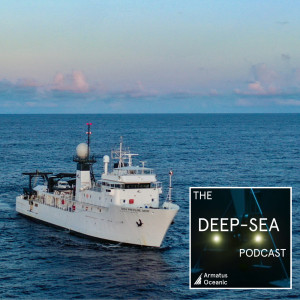
Friday Oct 07, 2022
028 – Masters of the sea with Stuart Buckle
Friday Oct 07, 2022
Friday Oct 07, 2022
The Professor is back from his adventures at sea with lots of exciting new updates. He talks us through some of his key findings from this already iconic deep-sea expedition. We also get to hear from an often overlooked figure in these expeditions: the ship's captain. Alan and Captain Stuart Buckle have a shared history of seagoing. Travelling the world together onboard the DSSV Pressure Drop during the Five Deeps expedition and during the Professor's recent venture to the Japanese trenches. Captain Stu talks us through his journey into becoming a captain and how he managed to bag the role of captain during James Cameron's legendary Mariana Trench dive.
We also hear from one of our favourite captains and long-time guest of the show, Don Walsh. Don recalls how he sharpened his skills in ship handling and his methods of teaching these skills to the next generation of sailors.
Check out our podcast merch! Which now includes Alan’s beloved apron.
Feel free to get in touch with us with questions or you own tales from the high seas on:
podcast@armatusoceanic.com
We’d love to actually play your voice so feel free to record a short audio note!
We are also on
Twitter: @DeepSeaPod, @ArmatusO
Facebook: DeepSeaPodcast, ArmatusOceanic
Instagram: @deepsea_podcast, @armatusoceanic
Keep up with the team on social media
Twitter:
Alan - @Hadalbloke
Thom - @ThomLinley
Georgia - @geeinthesea
Instagram:
Georgia - @geeinthesea
Read the show notes and find out more about us at:
www.armatusoceanic.com
Glossary
Benthic - Associated with the seafloor
Captain - The commanding officer of a ship.
Crinoids - Sea lilies are marine animals that are closely related to sea stars, sea cucumbers and sea urchins.
Ctenophores - Comb jellies are gelatinous marine invertebrates that use cilia for swimming.
ECDIS - An Electronic Chart Display and Information System shows the navigational charts and information about the position, heading and speed of a vessel.
Knots - The unit of speed equal to one nautical mile per hour. The Deep Sea Challenger ascended at 6 knots or approx 7mph.
Thrusters - The propellers on an underwater vehicle that allow it to move.
ROV - Remotely Operated Vehicles are underwater robots that collect data such as video/images. They are attached to a vessel by an umbilical cord.
Xenophyophore - A unicellular marine organism with lots of nuclei found on abyssal plains.
Links
Vulnerable deep-sea ecosystems get further protection from bottom fishing in EU waters
Deep-sea mining test given green light
UN Ocean Treaty fails to reach an agreement
Unidentified spiky blue goo seen in the deep
Australian fisherman catches kitefin shark
Megamouth shark filmed off the coast of San Diego
230 pilot whales stranded on beach in Tasmania
Nice Boys (Live) - Guns N’ Roses
Youtube
Spotify
Credits
Theme – Hadal Zone Express by Märvel
Logo image
Image courtesy of the DSSV Pressure Drop

Saturday Oct 01, 2022
The Deco-Stop – 001: Parents at sea with Kat Bolstad, deepest lactating human
Saturday Oct 01, 2022
Saturday Oct 01, 2022
Here’s our first ever episode of The Deco-Stop; a deeper look into the humans behind deep sea science and technology. We’ve done our science dive, and now it’s time to decompress, and discuss tales at sea, career paths and the social & political aspects of deep sea science.
Read the show notes and find the full episode here:
https://www.armatusoceanic.com/podcast/deco-stop-001
In our first ever episode, we talk to Kat Bolstad, the leader of the AUT lab for cephalopod ecology and systematics (ALCES) at Auckland University in New Zealand.
We talk about squid Christmas, chasing the colossal squid, Kat’s career journey and her truly incredible record of being the deepest lactating human (we think). She also tells us how she once made a liar out of Sir David Attenborough. We’re so excited about creating this space to talk more about the human aspects of deep-sea science, and would love to hear from you about your deep-sea journey!
Check out our podcast merch! Which now includes Alan’s beloved apron.
Feel free to get in touch with us with questions or your own tales from the high seas on:
podcast@armatusoceanic.com
We’d love to actually play your voice so feel free to record a short audio note!
We are also on
Twitter: @DeepSeaPod, @ArmatusO
Facebook: DeepSeaPodcast, ArmatusOceanic
Instagram: @deepsea_podcast, @armatusoceanic
Glossary
Architeuthis - The latin name for the giant squid.
Cephalopod - A class of molluscs which contains squids, octopus, nautilus and vampire squid.
Colossal squid - Mesonychoteuthis hamiltoni, a species of deep-sea squid believed to be the largest squid species in terms of mass.
Genetic Taxonomy - The classification and gathering of organisms into groups based on genetic similarity.
Giant squid - A species of gigantic deep sea squid which can grow to 10-12m long at maximum size.
Kondakovia - A species of deep-sea squid, which has now been reclassified as Moroteuthopsis.
Morphological Taxonomy - The classification and gathering of organisms into groups based on morphological similarities (similar physical features).
Moroteuthopsis - A species of deep-sea squid which was previously known as Kondakovia.
Octonauts - A children's TV programme which follows a group of underwater explorers.
Ommastrephes bartramii - The ‘neon flying squid’, a species of squid commonly fished in the North Pacific.
Links
Kat’s Research Lab - AUT Lab for Cephalopod Ecology and Systematics (ALCES)
Website
Twitter
Kat’s appearance in the NHK documentary series: Deep Ocean
S1. E4: Giants of the Antarctic Deep
Kat’s paper on the renaming of Kondakovia to Moroteuthopsis.
Kat’s paper on the distribution and biology of the colossal squid
Kat’s book chapter on The Study of Deep Sea Cephalopods
Kat’s paper on Moroteuthopsis diet—the one that ate a Bathyteuthis
‘Squid cube’
Credits
Theme – Hometime by Harvey Jones
Logo image - The Deco-Stop

Friday Sep 23, 2022
PRESSURISED: 002 – Exploring the Mariana Trench with Don Walsh
Friday Sep 23, 2022
Friday Sep 23, 2022
Our short and to the point PRESSURISED version of episode 2. If you don't have time for the full episode and want to get right to the science without any of our waffle, this is the place to be!
Read the show notes and find the full episode here:
https://www.armatusoceanic.com/podcast/002-exploring-the-mariana-trench-guest-don-walsh
In this episode we have an amazing interview with legendary oceanographer, Don Walsh. In 1960, Don and Jacques Piccard were the first people ever to reach the ocean’s deepest point – Challenger Deep in the Mariana Trench in the bathyscaphe Trieste. Since then, Don tends to get asked the same questions about the dive but he is full of other stories at least as interesting. Some include getting a tour of the heavens from his old dive buddy Arthur C. Clark, almost joining the Apollo Program and being involved in the first remote sensing of our oceans from space. He is still passionate about science communication and we discuss how important storytelling is when sharing science.
Check out our podcast merch! Which now includes Alan’s beloved apron.
Feel free to get in touch with us with questions or you own tales from the high seas on:
podcast@armatusoceanic.com
We’d love to actually play your voice so feel free to record a short audio note!
We are also on
Twitter: @DeepSeaPod, @ArmatusO
Facebook: DeepSeaPodcast, ArmatusOceanic
Instagram: @deepsea_podcast, @armatusoceanic
Glossary
Apollo programme - A USA space program carried out from 1961 to 1972 by NASA which landed the first astronauts on the Moon
Arthur C. Clarke - An English science-fiction writer, inventor and undersea explorer. He co-wrote the screenplay for the 1968 film 2001: A Space Odyssey, widely regarded as one of the most influential films of all time.
Bathyscaphe - A bathyscaphe is a self-propelled vehicle used for deep-sea dives.
Challenger Deep - The deepest known point on Earth (10,935m / 35,876 ft deep).
Mariana Trench - The deepest known underwater trench on Earth, located in the Pacific Ocean.
Credits
Theme – Hadal Zone Express by Märvel
Logo image - The Deep-Sea Podcast: PRESSURISED

Friday Sep 16, 2022
PRESSURISED: 027 – Cave biology with Thomas Iliffe
Friday Sep 16, 2022
Friday Sep 16, 2022
Our short and to the point PRESSURISED version of episode 27. If you don't have time for the full episode and want to get right to the science without any of our waffle, this is the place to be!
Read the show notes and find the full episode here:
https://www.armatusoceanic.com/podcast/027-caves
With the Professor out at sea, Thom goes off the rails and finally gets his answers on cave biology. What are the similarities and differences between the deep-sea and cave ecosystems? How are they linked? Do we know more about the moon than cave biolo…. just kidding! We speak to the legendary Professor Thomas Iliffe, who has shaped the field of biospeleology (cave biology); discovering over 250 species, and 3 new orders (now you don’t hear that every day)! He talks us through the formation of these habitats, what dive surveys are really like, and how to discover the most fascinating of organisms. We also hear from Martin Pollizotto, a listener (and expert cave diver) on bioluminescence in cave systems (or a lack thereof).
We had a lot of deep-sea news this month! New species are being discovered, Alvin is back in the water breaking previous depth records, we have new tech AND some interstellar news!
Check out our podcast merch! Which now includes Alan’s beloved apron.
Feel free to get in touch with us with questions or you own tales from the high seas on:
podcast@armatusoceanic.com
We’d love to actually play your voice so feel free to record a short audio note!
We are also on
Twitter: @DeepSeaPod, @ArmatusO
Facebook: DeepSeaPodcast, ArmatusOceanic
Instagram: @deepsea_podcast, @armatusoceanic
Glossary
Anchialine - Meaning “near the sea” in Greek, an anchialine pool is a landlocked body of water connected to the ocean via underground caves.
Blind cave fish - fish found living in deep caves with no eyes and usually no pigment.
Cenote - An underground cave system in Mexico.
Epigenetics - the study of how your behaviours and environment can affect the way your genes work.
Halocline - A vertical zone in the water column where the salinity changes rapidly from less saline to more saline (in caves this means the more dense salt water sits below the less dense fresher water).
Hermaphroditic - Possessing both male and female reproductive organs.
Order - (taxonomy) a way of giving organising species with other closely related species.
Remipede - A class of blind crustaceans found in marine caves.
Yucatan – A region of Mexico famous for its cenotes.
Links
Tom’s work in TV
Netflix Alien Worlds, Episode 1 (Atlas)
National Geographic Drain the Bermuda Triangle (starting @ 19:40)
Christmas Island Cave Diving Expedition
Tom’s Published Research
Bermuda’s Walsingham Caves: A Global Hotspot for Anchialine Stygobionts, Diversity 13(8), 352; https://doi.org/10.3390/d13080352
Monsters in the dark: systematics and biogeography of the stygobitic genus Godzillius (Crustacea: Remipedia) from the Lucayan Archipelago, European Journal of Taxonomy, 751(1), 115-139; https://doi.org/10.5852/ejt.2021.751.1383
Anchialine biodiversity in the Turks and Caicos Islands: New discoveries and current faunal composition, International Journal of Speleology, 49(2):71-86; https://digitalcommons.usf.edu/ijs/vol49/iss2/1/
Development of anchialine cave habitats and karst subterranean estuaries since the last ice age, Scientific Reports 9:11907; https://www.nature.com/articles/s41598-019-48058-8
California Dreamin’ - The Mamas & The Papas
Youtube
Spotify
Calcified deep sea infauna can be imaged with 3D acoustic coring system
It turns out sponges sneeze!
New species of deep sea isopod discovered
Paper
Researchers discover up to 39 new species
Paper
Equipment rescue reveals the biggest avalanche ever recorded on earth.
Alvin is back in the water after its refit
New area of hydrothermal vents found off of the coast of mexico
Scientists start the search for an interstellar meteor at the bottom of the ocean
Credits
Theme – Hadal Zone Express by Märvel
Logo image - The Deep-Sea Podcast: PRESSURISED
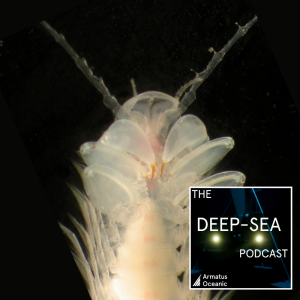
Saturday Sep 03, 2022
027 – Cave biology with Thomas Iliffe
Saturday Sep 03, 2022
Saturday Sep 03, 2022
Full episode notes
With the Professor out at sea, Thom goes off the rails and finally gets his answers on cave biology. What are the similarities and differences between the deep-sea and cave ecosystems? How are they linked? Do we know more about the moon than cave biolo…. just kidding! We speak to the legendary Professor Thomas Iliffe, who has shaped the field of biospeleology (cave biology); discovering over 250 species, and 3 new orders (now you don’t hear that every day)! He talks us through the formation of these habitats, what dive surveys are really like, and how to discover the most fascinating of organisms. We also hear from Martin Pollizotto, a listener (and expert cave diver) on bioluminescence in cave systems (or a lack thereof).
We had a lot of deep-sea news this month! New species are being discovered, Alvin is back in the water breaking previous depth records, we have new tech AND some interstellar news!
We announce yet another exciting spin-off, The Deco-Stop, where we plan on chatting to guests about the more human side of science. We heard from listeners that they are fascinated by scientists as people and the stories they have to tell, so we’re excited to open up the space to talk about scientists as individuals, and the topics where science interacts with human issues.
Check out our podcast merch! Which now includes Alan’s beloved apron.
Feel free to get in touch with us with questions or you own tales from the high seas on:
podcast@armatusoceanic.com
We’d love to actually play your voice so feel free to record a short audio note!
We are also on
Twitter: @DeepSeaPod, @ArmatusO
Facebook: DeepSeaPodcast, ArmatusOceanic
Instagram: @deepsea_podcast, @armatusoceanic
Read the show notes and find out more about us at:
www.armatusoceanic.com
Glossary
Anchialine - Meaning “near the sea” in Greek, an anchialine pool is a landlocked body of water connected to the ocean via underground caves.
Blind cave fish - fish found living in deep caves with no eyes and usually no pigment.
Cenote - An underground cave system in Mexico.
Epigenetics - the study of how your behaviours and environment can affect the way your genes work.
Halocline - A vertical zone in the water column where the salinity changes rapidly from less saline to more saline (in caves this means the more dense salt water sits below the less dense fresher water).
Hermaphroditic - Possessing both male and female reproductive organs.
Order - (taxonomy) a way of giving organising species with other closely related species.
Remipede - A class of blind crustaceans found in marine caves.
Yucatan – A region of Mexico famous for its cenotes.
Links
Tom’s work in TV
Netflix Alien Worlds, Episode 1 (Atlas)
National Geographic Drain the Bermuda Triangle (starting @ 19:40)
Christmas Island Cave Diving Expedition
Tom’s Published Research
Bermuda’s Walsingham Caves: A Global Hotspot for Anchialine Stygobionts, Diversity 13(8), 352; https://doi.org/10.3390/d13080352
Monsters in the dark: systematics and biogeography of the stygobitic genus Godzillius (Crustacea: Remipedia) from the Lucayan Archipelago, European Journal of Taxonomy, 751(1), 115-139; https://doi.org/10.5852/ejt.2021.751.1383
Anchialine biodiversity in the Turks and Caicos Islands: New discoveries and current faunal composition, International Journal of Speleology, 49(2):71-86; https://digitalcommons.usf.edu/ijs/vol49/iss2/1/
Development of anchialine cave habitats and karst subterranean estuaries since the last ice age, Scientific Reports 9:11907; https://www.nature.com/articles/s41598-019-48058-8
California Dreamin’ - The Mamas & The Papas
Youtube
https://youtu.be/oU6uUEwZ8FM
Spotify
https://open.spotify.com/track/4s6LhHAV5SEsOV0lC2tjvJ
Calcified deep sea infauna can be imaged with 3D acoustic coring system
It turns out sponges sneeze!
New species of deep sea isopod discovered
Paper
Researchers discover up to 39 new species
Paper
Equipment rescue reveals the biggest avalanche ever recorded on earth.
Alvin is back in the water after its refit
New area of hydrothermal vents found off of the coast of Mexico
Scientists start the search for an interstellar meteor at the bottom of the ocean
Credits
Theme – Hadal Zone Express by Märvel
Logo image
Image courtesy of Thomas Iliffe

Saturday Aug 27, 2022
PRESSURISED: 001 –The moon analogy
Saturday Aug 27, 2022
Saturday Aug 27, 2022
Our short and to the point PRESSURISED version of episode 1. If you don't have time for the full episode and want to get right to the science without any of our waffle, this is the place to be!
Read the show notes and find the full episode here:
https://www.armatusoceanic.com/podcast/episode1
In the very first episode of The Deep-Sea Podcast we let you know who we are and why we felt the world really needed a podcast about the deep sea. Alan rants about how the statement ‘we know more about the moon than the deep sea’ is not just a bad analogy, it’s plain wrong. Thom talks about how the quality of scientific writing is maintained. And our guest, Prof. Monty Priede, Editor-in-Chief of the scientific journal Deep-Sea Research Part I, talks about why there are no sharks in the abyssal zone.
Check out our podcast merch! Which now includes Alan’s beloved apron.
Feel free to get in touch with us with questions or your own tales from the high seas on:
podcast@armatusoceanic.com
We’d love to actually play your voice so feel free to record a short audio note!
We are also on
Twitter: @DeepSeaPod, @ArmatusO
Facebook: DeepSeaPodcast, ArmatusOceanic
Instagram: @deepsea_podcast, @armatusoceanic
Read the show notes and find out more about us at:
www.armatusoceanic.com
Links
Here are Monty’s open-access paper on the absence of sharks from the deeper ocean
And his book, Deep-Sea Fishes: Biology, Diversity, Ecology and Fisheries.
Credits
Theme – Hadal Zone Express by Märvel
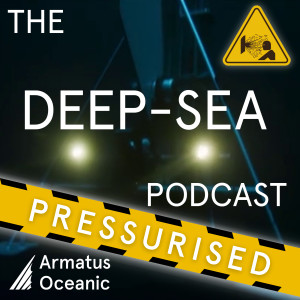
Saturday Aug 20, 2022
PRESSURISED: 026 – Vision in the deep sea with Justin Marshall
Saturday Aug 20, 2022
Saturday Aug 20, 2022
Our short and to the point PRESSURISED version of episode 26. If you don't have time for the full episode and want to get right to the science without any of our waffle, this is the place to be!
Read the show notes and find the full episode here:
https://www.armatusoceanic.com/podcast/026-vision
After recovering from you-know-what last episode, we’re excited to complete our open-water/pelagic trilogy with this week’s guest Professor Justin Marshall. Justin is an expert on all things vision, and talks us through all of the intricacies and oddities of vision in the deep sea. We discuss how fish eyes have evolved in order to adapt to the darkness of the deep, and how exactly they are able to see bioluminescence. Justin’s research has been highly influential, so we ask him more about his discoveries of mantis shrimp vision, and how he found out that cephalopods were colour-blind!
We also couldn’t let him leave without getting some of the stories from his time living in the underwater habitat for weeks, and how this led to somewhat horrifying fungal consequences.
The deep sea has seen a flurry of activity this month with lots of news to cover! MBARI has released a fascinating new video of a deep-sea squid brooding eggs. We cover some more paleo-news with surprising historical deep-sea temperatures and the discovery of new brine pools in the Red Sea.
It wouldn’t be the Deep-Sea Podcast without checking in with Don Walsh as he talks us through the history of submarine windows. And we also hear from a listener and find out how snailfish got their name.
Check out our podcast merch! Which now includes Alan’s beloved apron.
Feel free to get in touch with us with questions or your own tales from the high seas on:
podcast@armatusoceanic.com
We’d love to actually play your voice so feel free to record a short audio note!
We are also on
Twitter: @DeepSeaPod, @ArmatusO
Facebook: DeepSeaPodcast, ArmatusOceanic
Instagram: @deepsea_podcast, @armatusoceanic
Glossary
Abyssopelagic – open water 4-6 km (13,000 to 20,000 ft) deep
Bathypelagic – also known as the midnight zone, open water roughly 1-4 km (3,300-13,000 ft) deep
Bathytheuthis berryi – A deep sea squid which has been observed brooding eggs
Euphotic zone – the surface and well-illuminated zone
Hadalpelagic – open water >6 km deep
Mesopelagic – also called the twilight zone, starts where 1% of light reaches and ends where there is none, roughly 200-1,000 m (656-3,280 ft) deep
Pelagic – open ocean, away from the shore and the bottom
Photic zone – the depth that light penetrates
Rod/Cone cells – two types of photoreceptors which are used by animals to detect light to be able to ‘see’.
Underwater habitat – A structure created to allow people to live underwater for extended periods. Often used for research by aquatic biologists.
Links
Justin's Research Group
News article on the historical temperatures of the deep Atlantic ocean as warm as the Mediterranean
Original article published in Science on the historical Mediterranean-like temps of the deep sea
MBARI capture incredible video of a brooding squid, Bathytheuthis berryi
New brine pool discovered in the Red Sea
https://www.sciencedaily.com/releases/2022/07/220712102631.htm
Scientists discover the reason why deep-sea corals fluoresce
The ‘milky’ Java sea is caught on camera
Justin’s article on cephalopod colouration and sensitivity to light
Credits
Theme – Hadal Zone Express by Märvel
Logo image
Justin's Research Group
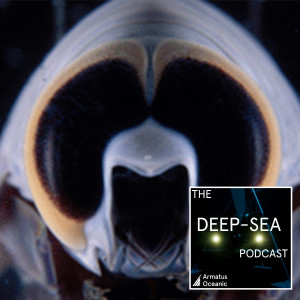
Friday Aug 05, 2022
026 – Vision in the deep sea with Justin Marshall
Friday Aug 05, 2022
Friday Aug 05, 2022
Read the show notes and find out more about us at:
https://www.armatusoceanic.com/podcast/026-vision
After recovering from you-know-what last episode, we’re excited to complete our open-water/pelagic trilogy with this week’s guest Professor Justin Marshall. Justin is an expert on all things vision, and talks us through all of the intricacies and oddities of vision in the deep sea. We discuss how fish eyes have evolved in order to adapt to the darkness of the deep, and how exactly they are able to see bioluminescence. Justin’s research has been highly influential, so we ask him more about his discoveries of mantis shrimp vision, and how he found out that cephalopods were colour-blind!
We also couldn’t let him leave without getting some of the stories from his time living in the Atlantis underwater habitat for weeks, and how this led to somewhat horrifying fungal consequences.
The deep sea has seen a flurry of activity this month with lots of news to cover! Our favourite cryptozoologist, Tyler Greenfield is at the epicentre of a monster-misunderstanding. Thom’s upset as yet another innocent fish is labelled the ‘ugliest creature ever seen’ by fishermen, but this time it’s a more familiar face. We also cover some more paleo-news with surprising historical deep-sea temperatures and the discovery of new brine pools in the Red Sea. Alan gives us an insight into his upcoming adventures at sea and we find out why he isn’t the biggest fan of documentarians.
It wouldn’t be the Deep-Sea Podcast without checking in with Don Walsh as he talks us through the history of submarine windows. And we also hear from a listener and find out what snailfish and The Kardashians have in common…
Check out our podcast merch! Which now includes Alan’s beloved apron.
Feel free to get in touch with us with questions or your own tales from the high seas on:
podcast@armatusoceanic.com
We’d love to actually play your voice so feel free to record a short audio note!
We are also on
Twitter: @DeepSeaPod, @ArmatusO
Facebook: DeepSeaPodcast, ArmatusOceanic
Instagram: @deepsea_podcast, @armatusoceanic
Glossary
Abyssopelagic – open water 4-6 km (13,000 to 20,000 ft) deep
Bathypelagic – also known as the midnight zone, open water roughly 1-4 km (3,300-13,000 ft) deep
Bathytheuthis berryi – A deep sea squid which has been observed brooding eggs
Coprophage – An animal that eats poop
Cryptozoology – The study of species whose existence is rumoured or disputed.
Euphotic zone – the surface and well-illuminated zone
Hadalpelagic – open water >6 km deep
Loch Ness – A loch (large freshwater lake) in the Scottish Highlands which is best known for the alleged sightings of the ‘Loch Ness Monster’ since 1933.
Mesopelagic – also called the twilight zone, starts where 1% of light reaches and ends where there is none, roughly 200-1,000 m (656-3,280 ft) deep
Monkfish – A wide-mouthed commonly-found fish who perhaps isn’t the most beautiful, but definitely could be considered tasty.
Pelagic – open ocean, away from the shore and the bottom
Photic zone – the depth that light penetrates
Rod/Cone cells – two types of photoreceptors which are used by animals to detect light to be able to ‘see’.
Underwater habitat – A structure created to allow people to live underwater for extended periods. Often used for research by aquatic biologists.
Links
We Build Spaceships
Spotify
YouTube
Justin's Research Group
Justin also has a citizen science program called Coral Watch which allows divers to report on coral health
Tyler’s blog on cryptozoology and his Twitter @TylerGreenfieId
News article dubbing yet another innocent fish as ‘the ugliest thing fisherman has ever seen’.
News article on the historical temperatures of the deep Atlantic ocean as warm as the Mediterranean
Original article published in Science on the historical Mediterranean-like temps of the deep sea
MBARI capture incredible video of a brooding squid, Bathytheuthis berryi
A paper on this squid
New brine pool discovered in the Red Sea
The ‘milky’ Java sea is caught on camera
Justin’s article on cephalopod colouration and sensitivity to light
Credits
Theme – Hadal Zone Express by Märvel
Logo image
Justin's Research Group

Friday Jul 22, 2022
PRESSURISED: 025 – Bioluminescence with Edie Widder
Friday Jul 22, 2022
Friday Jul 22, 2022
Our short and to the point PRESSURISED version of episode 25. If you don't have time for the full episode and want to get right to the science without any of our waffle, this is the place to be!
Read the show notes and find the full episode here:
https://www.armatusoceanic.com/podcast/025-biolum
Last episode we learned about the pelagic zone, the largest habitat on earth, a boundless 3D space where enormous migrations take place. We learned that this isn’t a world of darkness but rather one of biological light, where bioluminescence is used to attack, to defend and to communicate. While producing your own light may seem alien to us, it is likely the most common form of communication on the planet.
To learn more about this world we speak with Edie Widder, who has studied bioluminescence for her whole career and used the same adaptations found in the animals to design her own equipment. She developed the Eye in the Sea, a camera system invisible to most deep-sea animals, and a lure which emulated a bioluminescent jellyfish, the e-jelly. The gear worked extremely well and along with a lot of behaviours observed for the first time this also captured the first footage of the giant squid, Architeuthis dux.
In recent news we talk about how plate tectonics impact our climate, what we can learn from the evolution of cave animals and generating power from the thermocline. Don Walsh tells us why these bioluminescent creatures are a nuisance to submarines.
Check out our podcast merch!
Feel free to get in touch with us with questions or you own tales from the high seas on:
podcast@armatusoceanic.com
We’d love to actually play your voice so feel free to record a short audio note!
We are also on
Twitter: @DeepSeaPod, @ArmatusO
Facebook: DeepSeaPodcast, ArmatusOceanic
Instagram: @deepsea_podcast, @armatusoceanic
Links
Alien species invasion of deep-sea bacteria into mouse gut microbiota
Plate tectonics and climate
Paper
Blind cave animal evolution
Power generation from deep, cold water
Edith (Edie) Widder
Wikipedia
ORCA
Cookie-cutter shark paper
Below the Edge of Darkness
Credits
Theme – Hadal Zone Express by Märvel
Glossary
Bioluminescence – Biologically generated light
Cenozoic era – 50 million years ago when the earth started cooling
Cretaceous hothouse – 145-66 million years ago where temperatures were 10°C
Deep Worker – a small, single person sub
Electronic jellyfish – A bioluminescent bait
Esca – The lure on anglerfish
Eye in the sea – A red light illuminated camera with a electronic jellyfish as bait
Fermi bubbles – Listen to the end
Magnapinna – The genus of the bigfin squid
Marine snow – The biological material (bodies, poop and shells) singing into the deep sea
Moribund – Something that is dying and cannot be saved
Olm – A type of blind cave salamander
Photomultiplier – Tech that boosts very weak sources of light
Promachoteuthis – The genus of squid that was seen on Edie’s camera system
Squid jig – A lure used to fish for squid
Stoplight fish - Deep-sea dragonfishes of the genus Malacosteus that can both see and produce red light
Thermocline – layer of sudden temperature change in the sea
Tubeshoulder – Deep-sea fish with a specialised organ that squirts bioluminescent material
Wasp suit – A deep-sea diving suit
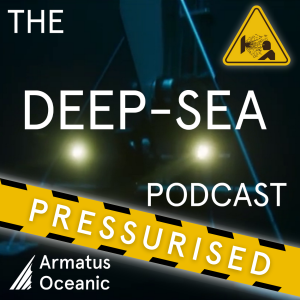
Saturday Jul 09, 2022
PRESSURISED: 024 – The pelagic deep sea with Tracey Sutton
Saturday Jul 09, 2022
Saturday Jul 09, 2022
Our short and to the point PRESSURISED version of episode 24. If you don't have time for the full episode and want to get right to the science without any of our waffle, this is the place to be!
Read the show notes and find the full episode here:
https://www.armatusoceanic.com/podcast/024-pelagic
We have a confession to make. We talk a big game about how we are busting myths, tackling deep-sea tropes and showing the deep ocean as it really is… but we have been guilty of one of the big ones. The deep sea is not just the bottom! Most of the deep sea, in fact, most of the habitat of this planet is the huge open 3D environment of open water or ‘pelagic’ water. In this staggering volume the planets largest migration takes place twice a day. Animals are locked in an evolutionary arms race, using their own light to deceive and trick. Finding a meal is rare, finding a mate is rare and life is without boundaries. These factors have led to some truly wild evolution.
We hear from Don about hunting for the 'deep scattering layer' (DSL) before we even knew what it was.
In recent news we cover Edith Widder and her new book Below the Edge of Darkness, underwater GPS through the power of a pong, following the yellow brick road to meet the deep-sea wizard and some lovely new footage of a highfin dragonfish.
Check out our podcast merch! Which now includes Alan’s beloved apron.
Feel free to get in touch with us with questions or you own tales from the high seas on:
podcast@armatusoceanic.com
We’d love to actually play your voice so feel free to record a short audio note!
We are also on
Twitter: @DeepSeaPod, @ArmatusO
Facebook: ArmatusOceanic
Instagram: @deepsea_podcast, @armatusoceanic
Read the show notes and find out more about us at:
www.armatusoceanic.com
Glossary
Abyssopelagic – open water 4-6 km (13,000 to 20,000 ft) deep
Aphotic zone – depths deeper than life penetrates
Bathypelagic – also known as the midnight zone, open water roughly 1-4 km (3,300-13,000 ft) deep
Benthic – associated with the bottom, how we usually think about the deep sea
Deep Scattering Layer (DSL) – a ‘false bottom’ created on sonar by huge numbers of open water animals
Dragonfish – deep-sea predators of the family Stomiidae
Dysphotic zone – the depth that light still penetrates but photosynthesis is becoming unviable
Euphotic zone – the surface and well illuminated zone
Hadalpelagic – open water >6 km deep
Mesopelagic – also called the twilight zone, starts where 1% of light reaches and ends where there is none, roughly 200-1,000 m (656-3,280 ft) deep
Myctophids – Lanternfish, fish responsible for the biggest carbon movements on the planet
Nictoepipelagic – The wink on the open sea. Great word for these vertical migrators
Pelagic – open ocean, away from the shore and the bottom
Photic zone – the depth that light penetrates
Vertical migration – the twice daily migration of deep-sea animals up to the surface to feed
Links
Tracey’s lab website
The synthesis paper of a decade of research into the Deepwater Horizon disaster. Open access
Carbon export model for mesopelagic fishes in the Gulf of Mexico
Edith Widder
Eye in the ocean
Edith’s new book
Vox podcast
Underwater GPS
Yellow-brick Road
Credits
Theme – Hadal Zone Express by Märvel
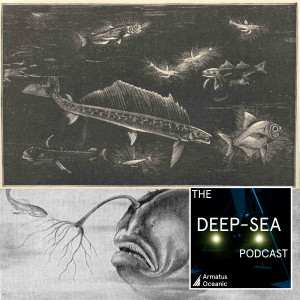
Saturday Jul 02, 2022
025 – Bioluminescence with Edie Widder
Saturday Jul 02, 2022
Saturday Jul 02, 2022
https://www.armatusoceanic.com/podcast/025-biolum
Sorry that this episode isn’t the perfectly polished jewel that this show usually is. Thom’s family got a visit from both COVID and chickenpox so there hasn’t been the time or energy to edit as well as he usually does. But we couldn’t abandon you without an episode this month as some great stuff is still covered.
Last episode we leaned about the pelagic zone, the largest habitat on earth, a boundless 3D space where enormous migrations take place. We learned that this isn’t a world of darkness but rather one of biological light, where bioluminescence is used to attack, to defend and to communicate. While producing your own light may seem alien to us, it is likely the most common form of communication on the planet.
To learn more about this world we speak with Edie Widder, who has studied bioluminescence for her whole career and used the same adaptations found in the animals to design her own equipment. She developed the Eye in the Sea, a camera system invisible to most deep-sea animals, and a lure which emulated a bioluminescent jellyfish, the e-jelly. The gear worked extremely well and along with a lot of behaviours observed for the first time this also captured the first footage of the giant squid, Architeuthis dux.
In recent news we talk about how plate tectonics impact our climate, what we can learn from the evolution of cave animals and generating power from the thermocline. We hear from a listener about their bigfin squid archive. Larkin drops by to tell us what a ‘Tron Dolphin’ and Don Walsh tells us why those same Tron Dolphins are a nuisance to submarines.
Feel free to get in touch with us with questions or you own comments on:
podcast@armatusoceanic.com
We’d love to actually play your voice so feel free to record a short audio note!
We are also on
Twitter: @DeepSeaPod, @ArmatusO
Facebook: ArmatusOceanic
Instagram: @deepsea_podcast, @armatusoceanic
Read the show notes and find out more about us at:
www.armatusoceanic.com
Check out our podcast merch!
Glossary
Bioluminescence – Biologically generated light
Cenozoic era – 50 million years ago when the earth started cooling
Cretaceous hothouse – 145-66 million years ago where temperatures were 10°C
Deep Worker – a small, single person sub
Electronic jellyfish – A bioluminescent bait
Esca – The lure on anglerfish
Eye in the sea – A red light illuminated camera with a electronic jellyfish as bait
Fermi bubbles – Listen to the end
Magnapinna – The genus of the bigfin squid
Marine snow – The biological material (bodies, poop and shells) singing into the deep sea
Moribund – Something that is dying and cannot be saved
Olm – A type of blind cave salamander
Photomultiplier – Tech that boosts very weak sources of light
Promachoteuthis – The genus of squid that was seen on Edie’s camera system
Squid jig – A lure used to fish for squid
Stoplight fish - Deep-sea dragonfishes of the genus Malacosteus that can both see and produce red light
Thermocline – layer of sudden temperature change in the sea
Tubeshoulder – Deep-sea fish with a specialised organ that squirts bioluminescent material
Wasp suit – A deep-sea diving suit
Links
Mötley Crüe - Hooligan's Holiday
Video
Spotify
Finding the Samule B Roberts, deepest wreck.
Tyler Greenfield on Twitter
Alien species invasion of deep-sea bacteria into mouse gut microbiota
Plate tectonics and climate
Paper
Blind cave animal evolution
Power generation from deep, cold water
Magnapinna Archive
Edith (Edie) Widder
Wikipedia
ORCA
Ted Talk
Cookie-cutter shark paper
Below the Edge of Darkness
Larkin’s YouTube channel, Instagram and TicTok
Credits
Theme – Hadal Zone Express by Märvel
Logo image
Public domain images
Holder, Charles Frederick (1892) Along the Florida Reef, New York City, NY: D. Appleton and Company, p. 263
Jordan, David Starr (1907) Fishes, New York City, NY: Henry Holt and Company
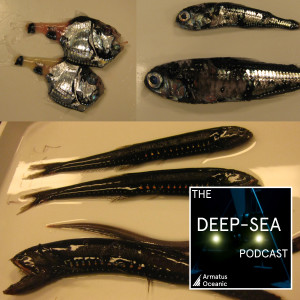
Friday Jun 03, 2022
024 – The pelagic deep sea with Tracey Sutton
Friday Jun 03, 2022
Friday Jun 03, 2022
https://www.armatusoceanic.com/podcast/024-pelagic
We have a confession to make. We talk a big game about how we are busting myths, tackling deep-sea tropes and showing the deep ocean as it really is… but we have been guilty of one of the big ones. The deep sea is not just the bottom! Most of the deep sea, in fact, most of the habitat of this planet is the huge open 3D environment of open water or ‘pelagic’ water. In this staggering volume the planets largest migration takes place twice a day. Animals are locked in an evolutionary arms race, using their own light to deceive and trick. Finding a meal is rare, finding a mate is rare and life is without boundaries. These factors have led to some truly wild evolution.
We also tackle a couple of listener questions: Whatever happened to the word ‘nictoepipelagic’ which seems to have vanished from scientific writing? We also discuss parasites in the deep sea, how can they find a specific host when the animals are so spread out? We hear from Don about hunting for the 'deep scattering layer' (DSL) before we even knew what it was and find out where Larkin has been from her new vessel on the Gulf of Mexico.
In recent news we cover Edith Widder and her new book Below the Edge of Darkness, underwater GPS through the power of a pong, following the yellow brick road to meet the deep-sea wizard and some lovely new footage of a highfin dragonfish.
We also find ourselves talking about how the deep sea is portrayed in children’s books and learn that apparently zesty citrus and floral smells are associated with the deep ocean… who knew?!
Feel free to get in touch with us with questions or you own tales from the high seas on:
podcast@armatusoceanic.com
We’d love to actually play your voice so feel free to record a short audio note!
We are also on
Twitter: @DeepSeaPod, @ArmatusO
Facebook: ArmatusOceanic
Instagram: @deepsea_podcast, @armatusoceanic
Read the show notes and find out more about us at:
www.armatusoceanic.com
Glossary
Abyssopelagic – open water 4-6 km (13,000 to 20,000 ft) deep
Aphotic zone – depths deeper than life penetrates
Bathypelagic – also known as the midnight zone, open water roughly 1-4 km (3,300-13,000 ft) deep
Benthic – associated with the bottom, how we usually think about the deep sea
Deep Scattering Layer (DSL) – a ‘false bottom’ created on sonar by huge numbers of open water animals
Dragonfish – deep-sea predators of the family Stomiidae
Dysphotic zone – the depth that light still penetrates but photosynthesis is becoming unviable
Euphotic zone – the surface and well illuminated zone
Hadalpelagic – open water >6 km deep
Mesopelagic – also called the twilight zone, starts where 1% of light reaches and ends where there is none, roughly 200-1,000 m (656-3,280 ft) deep
Myctophids – Lanternfish, fish responsible for the biggest carbon movements on the planet
Nictoepipelagic – The wink on the open sea. Great word for these vertical migrators
Pelagic – open ocean, away from the shore and the bottom
Photic zone – the depth that light penetrates
Vertical migration – the twice daily migration of deep-sea animals up to the surface to feed
Links
Tracey’s lab website
The synthesis paper of a decade of research into the Deepwater Horizon disaster. Open access
Carbon export model for mesopelagic fishes in the Gulf of Mexico
Rosetta stoned by TOOL
Youtube
Spotify
Edith Widder
Eye in the ocean
Edith’s new book
Vox podcast
Underwater GPS
Yellow-brick Road
Live stream
Best-of reel
Dragonfish and the Video
Rainbowfish discovers the deep sea
Deep Dive into Deep Sea
Larkin’s YouTube channel and Instagram
Credits
Theme – Hadal Zone Express by Märvel
Logo image
Some of Thom’s pics from the Mid-Atlantic
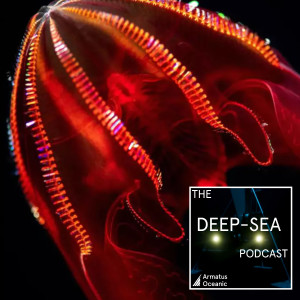
Saturday May 07, 2022
023 – Keeping deep-sea animals with The Monterey Bay Aquarium
Saturday May 07, 2022
Saturday May 07, 2022
https://www.armatusoceanic.com/podcast/023-deep-aquaria
Can we safely bring deep-sea organisms to the surface and keep them alive? Certain species, such as the giant isopods and giant Japanese spider crabs have been kept in aquaria in the past but the number of animals we can maintain long-term is quite small. The Monterey Bay Aquarium’s new Into the Deep exhibition has succeeded in keeping animals never before put on public display, some are even new to science. Not only that, but they have even had some success in getting them to reproduce! Figuring out what conditions these animals need and observing them over long periods will allow us to learn huge amounts about animals we usually only get a glimpse of. We talk with aquarists Ellen Umeda and Michelle Kaiser and life-support engineer Brian Maurer about the years of work that went into keeping these animals and giving the public a very personal deep-sea experience.
In the rest of the episode, Alan is back in the UK and we get to record in ‘the very quiet room’. We discuss data sharing and the complexities of charging for data that may otherwise not be taken, visiting the Explorers Club in New York and language barriers within science.
I also call Alan’s bluff and present him with a lovely Deep-Sea Podcast apron which he then proceeds to wear in Hell’s Kitchen in New York.
We hear from a listener about how the podcast helped them through a difficult time and answer a listener question about the danger of entanglement for undersea vehicles. If you’d like to record a question or comment please do and send it to the email below. We would love to include you on the show.
Check out our podcast merch! Which now includes Alan’s beloved apron.
Feel free to get in touch with us with questions or you own tales from the high seas on:
podcast@armatusoceanic.com
We are also on
Twitter: @DeepSeaPod, @ArmatusO
Facebook: ArmatusOceanic
Instagram: @deepsea_podcast, @armatusoceanic
Glossary
AUV – Autonomous Underwater Vehicle
Gravid – the animal is full of eggs and getting close to spawning
Laminar flow – a simple water flow, no eddies
ROV – Remotely Operated Vehicle
Spawning – release of eggs and sperm
Vertical migrator – animals that rise up from the deep sea at night to feed at the surface
Links
Our new merch!
Let ‘Em Go by The Wildhearts
Spotify
Video
The Explorers Club
TMAO in molecular machines
Mapping the ocean floor
Scientific Tower of Babel
Into the Deep:
Aquarium YouTube Channel
Online exhibition
Deep-sea adaptation story with video
Bioluminescence story with video
Animal information story
Exhibition development with life support diagram
Credits
Theme – Hadal Zone Express by Märvel
Logo image
Bloody-belly comb jelly – Monterey Bay Aquarium
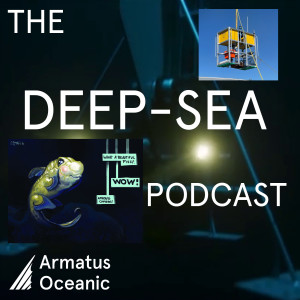
Friday Apr 01, 2022
022 – Live-streaming the deep with Kasey Cantwell
Friday Apr 01, 2022
Friday Apr 01, 2022
https://www.armatusoceanic.com/podcast/022-dive-streaming
One of the most exciting parts of our job is going to places that no one has ever been before and seeing things that no one has ever seen. It turns out, we were making that far harder than it needs to be, we can do all this from home! Several of the big names in deep-sea exploration live-stream (or dive-stream if we’re being cute). With just a few seconds delay, you can see deep-sea exploration as it happens and may be present for very significant finds. You never know what you’re going to find down there.
The big players in this space are the Schmidt Ocean Institute, Nautilus Live from the Ocean Exploration Trust and Ocean Exploration/Okeanos Explorer from NOAA. We are lucky enough to chat with Kasey Cantwell, the Operations Chief of the NOAA Ocean Exploration Expeditions and Exploration Division. We talk about the amazing opportunities this new way of doing science presents. From allowing 300 experts to take part, to swapping out your expert team when you find something unexpected and even the physical and societal barriers that can be removed. But it’s not just about getting science done, it’s about sharing these experiences with everyone. Online communities are forming around these streams and illustrations, poetry and memes are just as valid outputs.
In recent news we hear how preparations are going for Alan’s upcoming cruise. We talk about the octopus garden providing a nice warm spot to brood eggs, living underwater for long periods of time and the evolution of early vamperoids.
No episode would be complete without our regular check-in with Don Walsh to hear about his involvement with the early days of ROV and AUV research.
Check out our podcast merch! Please do send in any pics of you wearing the merch. We find the idea of real people in the actual world wearing this so surreal!
We also have a UK-based job advertised. Why not come and help us with the podcast and some other fun stuff. More details here.
Feel free to get in touch with us with questions or you own tales from the high seas on:
podcast@armatusoceanic.com
We are also on
Twitter: @ArmatusO
Facebook: ArmatusOceanic
Instagram: @armatusoceanic
Read the show notes and find out more about us at:
www.armatusoceanic.com
Glossary
AUV – Autonomous Underwater Vehicle
Berth – Beds available onboard a ship basically
Manganese nodule – potato shaped balls of metal that form on the seabed, the focus of deep-sea mining
ROV – Remotely Operated Vehicle
Taxonomist – A specialist in categorising a specific group of species.
Telepresence – Live-streaming what you’re doing on the internet
Links
Our new merch!
Tangaroa by Alien Weaponry
YouTube
Spotify
Octopus brooding in warm water
Article
Conference abstract
Living under the sea
Fabien Cousteau (Jacques Cousteau’s grandson) undersea live-in labs
Aquarious undersea lab
Two weeks under the sea
Earliest vampire squid
Article
Paper
Discovery of Shackleton’s ship, the Endurance
Paper that predicted that it would be intact
The Galathea Legacy - book - JohnQuentin.com
Start dive-streaming yourself!
NOAA Ocean Exploration
Schmidt Ocean Institute
Nautilus Live
Become part of the online community!
Livestream Oceanographic Discord
Look out for expedition names as hashtags on Twitter
Credits
Theme – Hadal Zone Express by Märvel
Logo image
Alan’s new lander systems being loaded aboard
“We found a deep sea fish and told it it was beautiful” - Live-stream inspired art by C. B. Sorge - cbsorgeartworks.tumblr.com
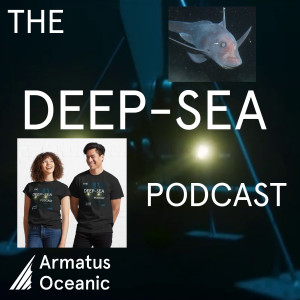
Friday Mar 04, 2022
021 – Collaborative data repositories and AI with Kakani Katija
Friday Mar 04, 2022
Friday Mar 04, 2022
We have often talked about how difficult it is the get data from the deep sea… but would you believe that the bottleneck to our understanding of the deep ocean, at least as far as visual data, is processing those images? Turning a picture of the deep sea into a list of species, habitat type, sediment type etc. is a time-consuming process that requires a wide range of skilled people.
Due to time/funding constrains a lot of valuable information is lost. A team looking at a specific question will have lots of information in their data that other teams could use.
A picture is worth a thousand data points.
We chat with Dr Kakani Katija, the co-founder of FathomNet, an open-source repository for labelled deep-sea imaging data. The platform is still in beta but it is hoped that it will allow scientists to easily and usefully share their amassed data in a single and easily searchable place.
But what about that processing bottleneck? The tech-savvy listener may have noticed that a massive collection of labelled image data is exactly the sort of thing you need to train a Machine Learning or Deep Learning algorithm. Can we automate a lot of the time-consuming image processing and let the experts focus on the new and unusual stuff? It’s at this cutting edge that things get exciting and we may be at the cusp of a marine science renaissance.
We have all our usual nonsense. Alan continues to find things in Australia that want to kill him. We answer some listener questions on deep-sea fish memory and Thom and Alan’s origin story. We also hear from Don about his time on the cruise ships. A decidedly un-deep-sea segment but it could be considered ‘adventure’ on the high seas.
We also launch our podcast merch! Please do send in any pics of you wearing the merch. We find the idea of real people in the actual world wearing this so surreal!
Feel free to get in touch with us with questions or you own tales from the high seas on:
podcast@armatusoceanic.com
We are also on
Twitter: @ArmatusO
Facebook: ArmatusOceanic
Instagram: @armatusoceanic
Read the show notes and find out more about us at:
www.armatusoceanic.com
Glossary
Artificial Intelligence (AI) – A science dedicated to making machines think in an intelligent way, mirroring a biological brain.
Data pipeline – A path that raw data follows to become useful information.
Deep Learning – a more complex subset of ML that mirrors the way a brain works
Machine Learning (ML) – computers learning to perform a task without being explicitly programmed to do so
ML/AI model or algorithm – A model that has been trained on real data and can now process new data itself.
Online Repository – A database stored online so that people can access it from anywhere
Open Source – A publicly accessible design that people can freely repurpose and adapt.
Visual data – photos or video as a form of scientific data
Links
Our new merch!
Abyssal EDNA article and Paper
Our Angola fish paper and the Open access version
Kakani’s Twitter
FathomNet goodies
The FathomNet website – have an explore of the labelled deep-sea critter data
FathomNet GitHub – take a peek under the hood or even get involved
FathomNet articles with tutorials/explanations
Helpful video tutorials
Paper
NOAA Science Seminar, 8 March 2022 1200-1300 PST (UTC-8)
Register now!
FathomNet Workshop, 31 March & 1 April 2022 0800-1100 PST (UTC-8)
Register now!
Internet of Elephants (gamifying processing camera-trap data)
Beyond Blue (game)
Credits
Theme – Hadal Zone Express by Märvel
Logo image
An image of the small-eyed rabbitfish (Hydrolagus affinis) we took off West Africa
Some of our new merch!







